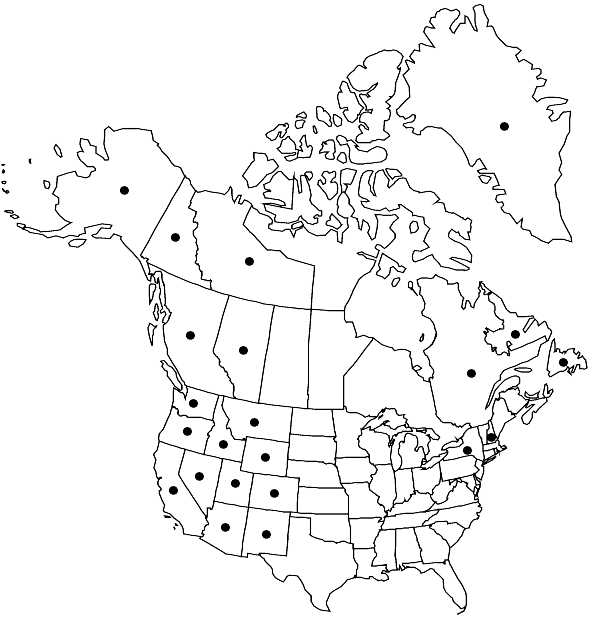Grimmia sessitana
Atti Reale Univ. Genova 1: 704. 1869,.
Plants in dense patches, dark green, brown-green, sometimes almost black. Stems 0.5–1 cm, central strand strong. Leaves lanceolate to ovatelanceolate, 1–1.8 × 0.2–0.6 mm, keeled, not plicate, one margin commonly recurved, sometimes both plane, awn 0.3–0.8 mm, costal transverse-section prominent, semicircular; basal juxtacostal laminal cells rectangular to elongate, straight, thin-walled; basal marginal laminal cells short to long-rectangular, straight, thick transverse and thin lateral walls, hyaline or not; medial laminal cells quadrate, sinuose, thick-walled; distal laminal cells 1-stratose, often bulging, marginal cells widely 2-stratose, often bulging. Sexual condition cladautoicous, perichaetial leaves not enlarged. Seta straight, 1–2.5 mm. Capsule usually present, exserted, yellow, ovoid to elliptic, exothecial cells short-rectangular, thin-walled, stomata present, annulus of 1 row of quadrate, thick-walled cells, operculum conic, usually with a short obtuse beak, peristome present, fully-developed, split or solid in distal half.
Habitat: Exposed or sheltered, moist, acidic granite and sandstone, alpine
Elevation: moderate to high elevations (1100-3900 m)
Distribution

Greenland, Alta., B.C., Nfld. and Labr., N.W.T., Que., Yukon, Alaska, Ariz., Calif., Colo., Idaho, Mont., Nev., N.H., N.Mex., N.Y., Oreg., Utah, Wash., Wyo., South America (Argentina), South America (Chile), Eurasia, Africa (Kenya), Africa (South Africa), Africa (Uganda), Antarctic
Discussion
Grimmia sessitana is widely distributed in high elevation sites throughout western North America, principally in mountains forming the continental divide, but also in the northern Sierra Nevada and the coastal range of Oregon and Washington. It is rare in eastern North America, but occurs in the northern Appalachians of the United States, on the Gaspé Peninsula of Quebec, and in Labrador. This is the least xerophilous member of the group; specimens have been collected in runoff zones from late-lying snow patches in the alpine. It is very rare in the dry interior mountains of the American Southwest. Grimmia sessitana is gametophytically variable and often difficult to identify with certainty. The presence of stomata and the autoicous condition separate this species from both G. montana and G. alpestris, which are the most common misidentifications. Confirming the presence or absence of stomata requires careful dissection of the capsule, including the neck, as the stomata are often just distal to the attachment of the seta. Sexuality can be difficult to determine, as G. sessitana is cladautoicous. If one leaf margin is recurved this will confirm the identification. However, some specimens may have plane margins. The presence of bulging-mammillose cells should separate G. sessitana from G. montana, but a significant number of specimens of G. sessitana have only weakly bulging laminal cells. Thus, specimens with capsules and antheridia are usually identifiable, while sterile specimens may be problematic. The other species that is often confused with G. sessitana is G. donniana. Both species have capsules with stomata and are autoicous. However, G. donniana very consistently has leaves with plane margins, uniform basal areolation with hyaline, narrowly rectangular thin-walled cells, and laminal cells that do not bulge. Grimmia sessitana appeared in H. A. Crum and L. E. Anderson’s (1981) flora of eastern North America as G. tenerrima. E. Lawton (1971), who accepted autiocous specimens in the concept of G. alpestris, excluded G. sessitana from the flora of the Pacific Northwest. J. Muñoz (1998b) put G. sessitana in synonymy with G. reflexidens but this is not correct.
Selected References
None.
Lower Taxa
"thin" is not a number.